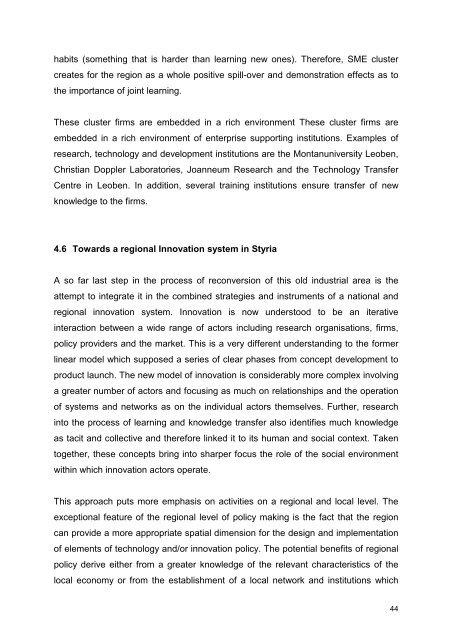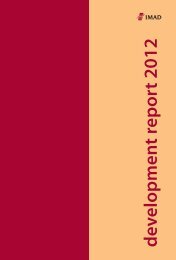Institutional Change in Old Industrial Areas – Lessons for ... - UMAR
Institutional Change in Old Industrial Areas – Lessons for ... - UMAR
Institutional Change in Old Industrial Areas – Lessons for ... - UMAR
You also want an ePaper? Increase the reach of your titles
YUMPU automatically turns print PDFs into web optimized ePapers that Google loves.
habits (someth<strong>in</strong>g that is harder than learn<strong>in</strong>g new ones). There<strong>for</strong>e, SME cluster<br />
creates <strong>for</strong> the region as a whole positive spill-over and demonstration effects as to<br />
the importance of jo<strong>in</strong>t learn<strong>in</strong>g.<br />
These cluster firms are embedded <strong>in</strong> a rich environment These cluster firms are<br />
embedded <strong>in</strong> a rich environment of enterprise support<strong>in</strong>g <strong>in</strong>stitutions. Examples of<br />
research, technology and development <strong>in</strong>stitutions are the Montanuniversity Leoben,<br />
Christian Doppler Laboratories, Joanneum Research and the Technology Transfer<br />
Centre <strong>in</strong> Leoben. In addition, several tra<strong>in</strong><strong>in</strong>g <strong>in</strong>stitutions ensure transfer of new<br />
knowledge to the firms.<br />
4.6 Towards a regional Innovation system <strong>in</strong> Styria<br />
A so far last step <strong>in</strong> the process of reconversion of this old <strong>in</strong>dustrial area is the<br />
attempt to <strong>in</strong>tegrate it <strong>in</strong> the comb<strong>in</strong>ed strategies and <strong>in</strong>struments of a national and<br />
regional <strong>in</strong>novation system. Innovation is now understood to be an iterative<br />
<strong>in</strong>teraction between a wide range of actors <strong>in</strong>clud<strong>in</strong>g research organisations, firms,<br />
policy providers and the market. This is a very different understand<strong>in</strong>g to the <strong>for</strong>mer<br />
l<strong>in</strong>ear model which supposed a series of clear phases from concept development to<br />
product launch. The new model of <strong>in</strong>novation is considerably more complex <strong>in</strong>volv<strong>in</strong>g<br />
a greater number of actors and focus<strong>in</strong>g as much on relationships and the operation<br />
of systems and networks as on the <strong>in</strong>dividual actors themselves. Further, research<br />
<strong>in</strong>to the process of learn<strong>in</strong>g and knowledge transfer also identifies much knowledge<br />
as tacit and collective and there<strong>for</strong>e l<strong>in</strong>ked it to its human and social context. Taken<br />
together, these concepts br<strong>in</strong>g <strong>in</strong>to sharper focus the role of the social environment<br />
with<strong>in</strong> which <strong>in</strong>novation actors operate.<br />
This approach puts more emphasis on activities on a regional and local level. The<br />
exceptional feature of the regional level of policy mak<strong>in</strong>g is the fact that the region<br />
can provide a more appropriate spatial dimension <strong>for</strong> the design and implementation<br />
of elements of technology and/or <strong>in</strong>novation policy. The potential benefits of regional<br />
policy derive either from a greater knowledge of the relevant characteristics of the<br />
local economy or from the establishment of a local network and <strong>in</strong>stitutions which<br />
44
















